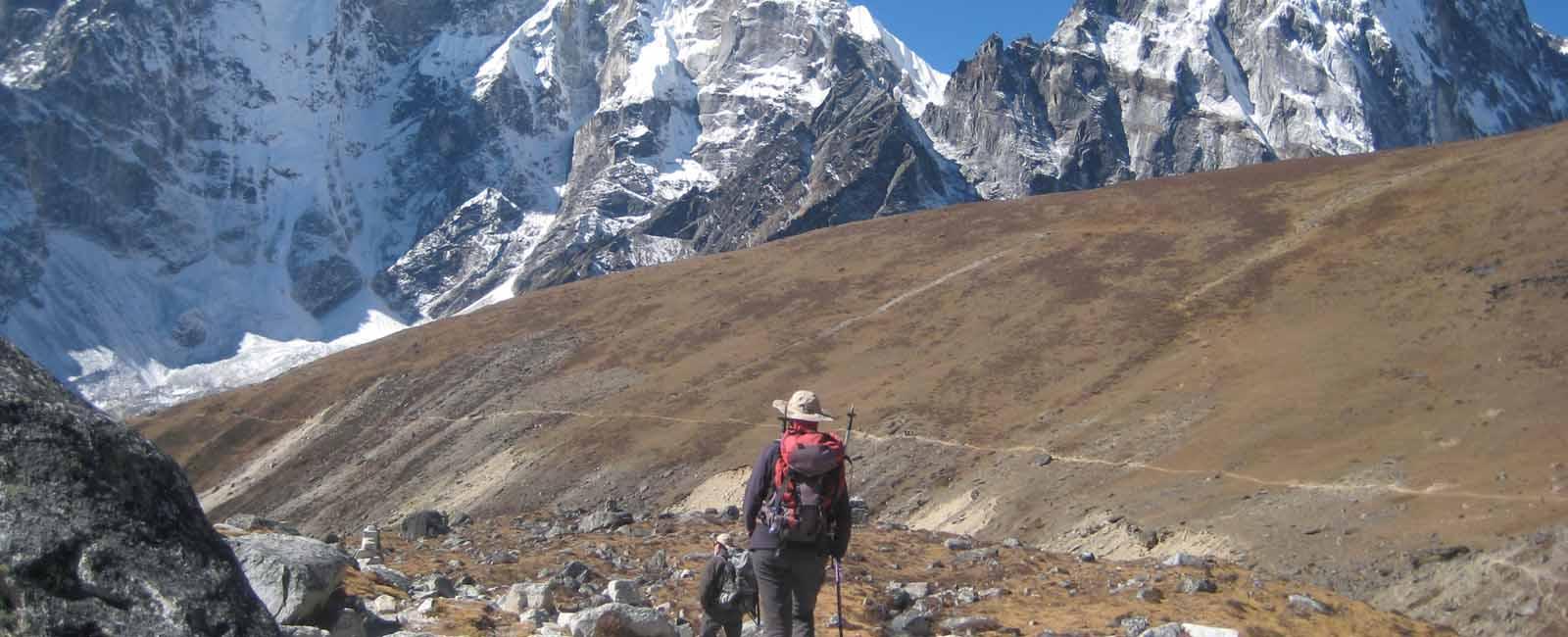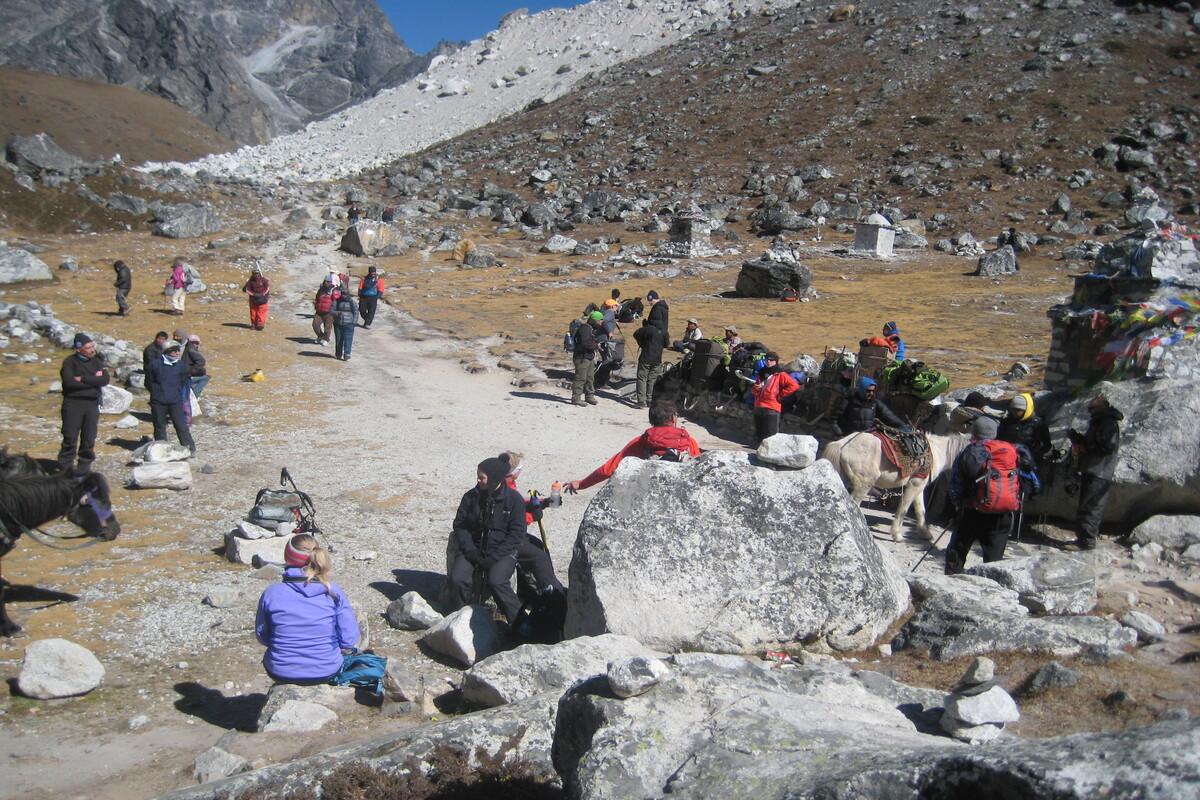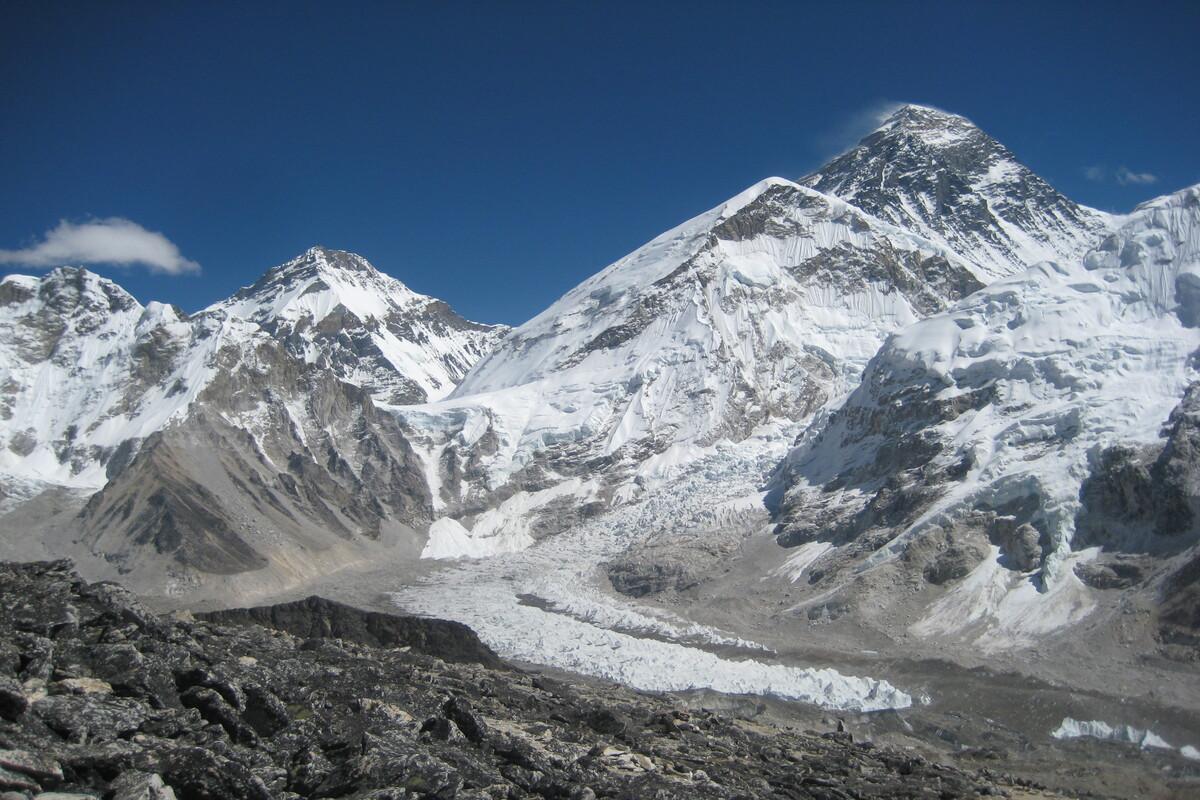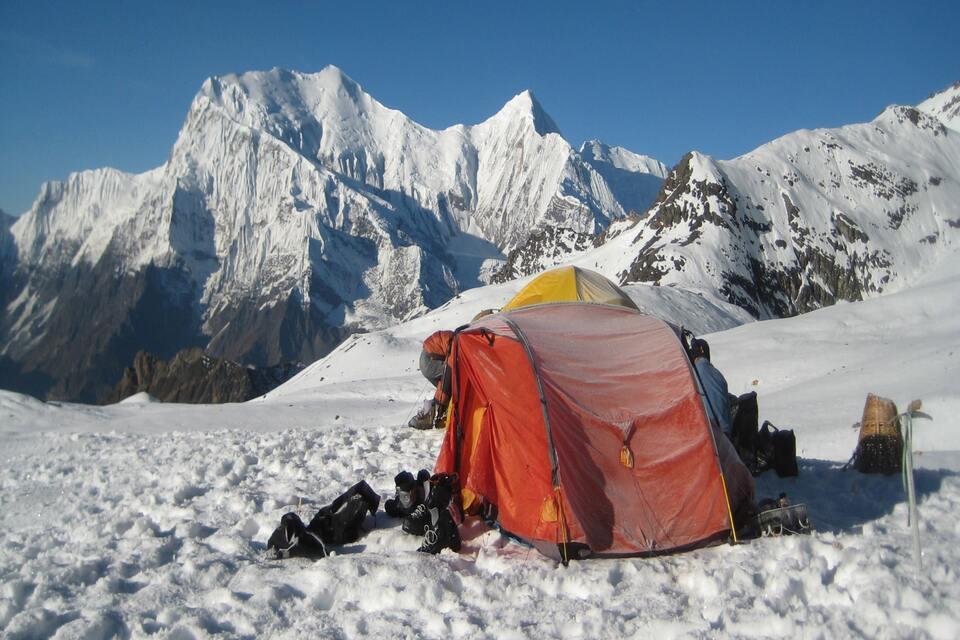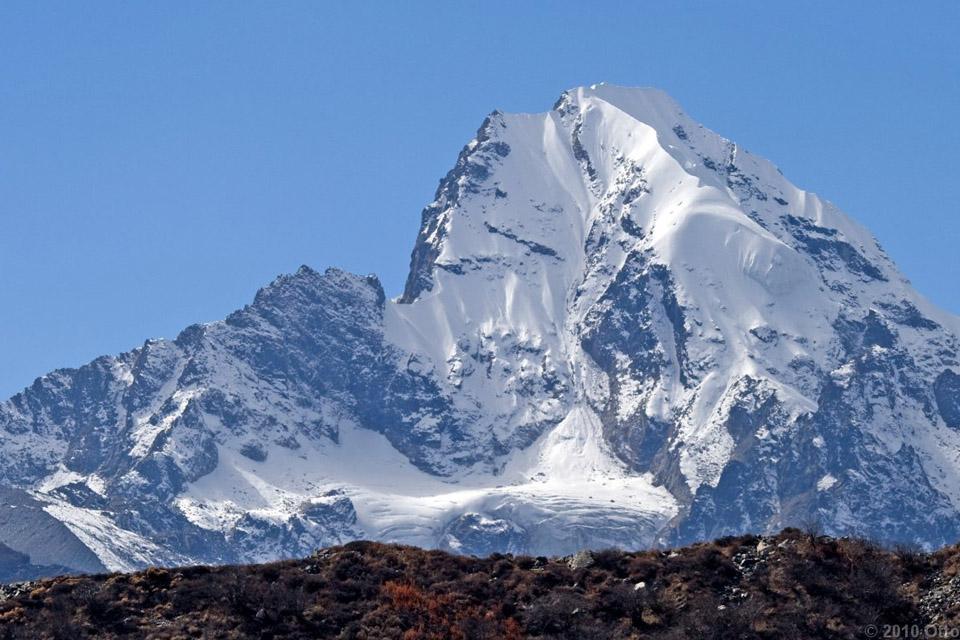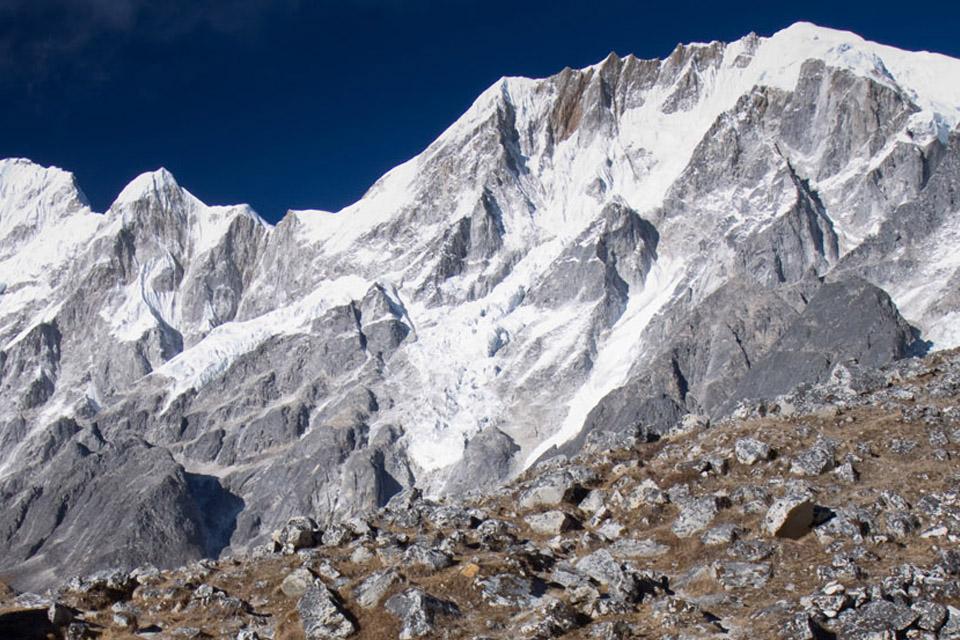Everest Base Camp and Island peak climbing
Trip at a Glance
Everest Base Camp and Island peak climbing are two popular activities in the Everest region of Nepal. Island Peak, also known as Imja Tse, is a popular climbing peak standing at an altitude of 6,189 meters (20,305 feet). It offers stunning panoramic views of the surrounding mountains, including Mount Everest. Island Peak climbing requires technical skills, including the use of ice axes, crampons, and ropes.
The EBC trek is a famous trekking route that takes you to the base camp of Mount Everest, the world's highest peak. The trek starts from Lukla and goes through beautiful Sherpa villages, rhododendron forests, and high-altitude landscapes. Along the way, you will pass through Namche Bazaar, Tengboche Monastery, and other scenic spots.
Everest Base Camp and Island peak climbing Highlights:
- Take off on a scenic flight to Lukla
- Sagarmatha National Park, where Mount Everest is located
- Explore Namche Bazar, the biggest town in the Khumbu region
- Hike up to the Everest panorama Hotel in Namche
- Tengboche monastery, the spiritual center of the Khumbu
- Step foot in the foothills of Mount Everest, the highest mountain in the world
- Get the closest view of Mount Everest from Kala Pathar
- World's highest glacier, the Khumbu Glacier
- Ascend to the summit of Island Peak Climb & take in the panoramic views of the mountains from Island Base Camp
Island Peak Climbing Difficulty
Imja Tse, another name for Island Peak, is a popular "trekking peak" in Nepal's Everest region. Although it's frequently thought to be accessible with basic mountaineering experience, it's actually a significant challenge and there are technical climbing sections. Climbers have to cross rocky terrain, steep slopes of snow and ice, and a demanding summit ridge. Crampons, ice axes, and ropes are among the mountaineering gear needed for the ascent.
The ascent is strenuous and calls for a high level of stamina and fitness. Climbers need to be ready to hike and climb at high elevations for extended periods of time. The last climb to the top might be quite demanding.
The elevation of Island Peak is 6,189 meters (20,305 ft). You run a serious risk of developing altitude sickness at this high altitude, which can seriously impact your climbing ability. Acclimatization must be done correctly.
In the Everest region, the weather is unstable and subject to sudden changes. Climbers need to be ready for severe weather, such as freezing temperatures, snow, and strong winds. Technical climbing skills are needed to scale the steep, mixed-rock and ice headwall before the summit ridge. Attempting Island peak are for those who have previously trekked and are in good physical condition and have used climbing equipment before and have some basic mountaineering skills.
How to combine Everest Base Camp trek with Island Peak climb
Combining an Island Peak climb with the Everest Base Camp (EBC) trek is a popular and advantageous experience that combines traditional trekking and mountaineering.
Excellent acclimatization is provided by the EBC journey itself, which is essential for climbing Island Peak. This is a significant benefit of merging the two. The EBC trek's steady elevation gain gets your body ready for Island Peak's higher elevations.
The itinerary is thoughtfully designed to provide enough time for the ascent and acclimatization.
After finishing the EBC trip, attention usually turns to Island Peak. After arriving at EBC, this frequently entails trekking to Chhukung, the entrance to Island Peak.
Island peak climbing itinerary
Arrival in Kathmandu:
Arriving Kathmandu and getting ready for the trek.
Lukla to Namche Bazaar
After taking a flight to Lukla, start the hike to Namche Bazaar to give yourself time to acclimate.
Acclimatization in Namche Bazaar
To acclimate, spend a day or two in Namche Bazaar.
Trek to Everest Base Camp
Continue on your trek to Everest Base Camp, stopping at villages such as Tengboche and Dingboche.
Everest Base Camp and Kala Patthar
For sweeping views of Everest, ascend Kala Patthar after arriving at Everest Base Camp.
Trek to Chhukung
Trek to Chhukung, the base of Island Peak, from the EBC area.
Island Peak Base Camp
Trek to Base Camp at Island Peak.
Island Peak Summit
Summit Island Peak and head back to Chhukung or base camp.
Return Trek to Lukla
Return to Lukla by trekking down the valley.
Flight to Kathmandu
Take a plane back to Kathmandu from Lukla.
Departure
Fly back home.
Island Peak climbing safety and preparation tips after EBC
For preparation for the climb, review the basics of mountaineering, such as how to use ropes, crampons, and ice axes, even if you have climbing expertise. Before the climb, practice these skills. Make sure all of your climbing equipment is in good shape. Check for any indications of wear or damage on your boots, crampons, harness, helmet, and ropes.
After finishing the Everest Base Camp (EBC) trip, climbing Island Peak provides a special acclimatization benefit. The risk of altitude sickness during the Island Peak ascent is greatly decreased by the good acclimatization provided by the EBC trip. Don't think you're completely acclimated, though. Keep an eye out for any indications of altitude sickness in your body.
For safety go with certified and seasoned climbing guide who are knowledgeable about Island Peak. Having a guide with extensive knowledge in high altitude mountaineering is crucial. Make proper use of ropes and harnesses, particularly when traveling on glaciers and on steep terrain. Make sure you comprehend and use appropriate belaying procedures.
Keep up a healthy level of physical fitness for the EBC hike. To keep your muscles loose, maintain stretching and doing mild exercise. Resilience and mental endurance are necessary for climbing Island Peak. Remain focused and concentrated, particularly throughout the difficult parts.
Island Peak Climbing Permits
Several permits are needed to climb Nepal's Island Peak (Imja Tse).
Sagarmatha National Park Entry Permit:
In order to access Island Peak, Sagarmatha National Park, this permit is necessary. For the Everest region, this is a general admission permit.
Khumbu Pasang Lhamu Rural Municipality Entrance Permit
Entering the Khumbu region requires a local government permit known as the Khumbu Pasang Lhamu Rural Municipality Entrance Permit.
Island Peak Climbing Permit
The special climbing permit granted by the Nepal Mountaineering Association (NMA) is known as the Island Peak Climbing Permit (NMA Trekking Peak Permit). The climbing season affects how much this permit costs.
1) Sagarmatha National Park Entry Permit fee for foreigners: NPR 3,000 (Approx. USD22)
2) Khumbu Pasang Lhamu Rural Municipality Entrance Permit fee for foreigners: NPR 3,000 (Approx. USD22)
3) Royalty for Foreign climbers for Island peak (per person in US dollar)
Spring (March-April-May) USD250
Autumn (Sept-Oct-Nov) USD125
Winter (Dec-Jan-Feb) USD70
Summer June-July-Aug) USD70
4) Garbage deposit USD500 (Refundable)
Itinerary
Day 01: Arrival in Kathmandu
Day 02: In Kathmandu - Climb preparation
Day 03: Fly from Kathmandu to Lukla (2840m/40 min) & trek to Phakding (2610 m/3-4 hrs)
Day 04: Trek from Phakding to Namche Bazaar (3440m/5-6 hrs)
Day 05: Rest day in Namche Bazaar for Acclimatization & Hike to Hotel Everest View (3880m/3-4 hrs)
Day 06: Trek from Namche Bazaar to Tengboche (3860m/5-6 hrs )
Day 07: Trek from Tengboche to Dingboche (4410m/5-6 hrs)
Day 08: Rest Day In Dingboche; Hike to Chhukung (4730m) & back to Dingboche (4410m/3-4 hrs)
Day 09:Trek from Dingboche to Lobuche (4910m/5-6 hrs)
Day 10: Trek from Lobuche to Gorakshep (5140m) / Hike to to Everest Base Camp (5364 m) & back to Gorakshep (8-9 hrs)
Day 11: Hike to Kalaphathar (5,555m) & trek back to Lobuche (4910m/5 hrs)
Day 12: Trek from Lobuche via Khongma La (5535m) to Chhukung (4,730m/6-7 hrs)
Day 13: Trek from Chhukung to Island Peak Base Camp (5000m/4 hrs)
Day 14: Summit Island peak summit (6189m) & back to Chhukung (10-11 hrs)
Day 15: Reserve day for summit
Day 16: Trek from Chhukung to Tengboche (3,870m/6 hrs)
Day 17: Trek from Tengboche to to Namche Bazaar (3,441m/6 hrs)
Day 18: Trek from Namche to Lukla (2,850m/6 hrs)
Day 19: Flight from Lukla to Kathmandu (1400m/40min)
Day 20: Final Departure
Arrive in Kathmandu and one of our representatives will receive you and transfer you to your hotel in Kathmandu. The rest of the time is free to explore the city where your hotel is located which is usually at Thamel – the popular tourist hub in Kathmandu where every needs and facilities for the tourist are located like hotels, pubs, restaurants, departmental stores, trek gear shops etc. Or you can simply rest at your hotel if you are jet lagged and get ready for an amazing Himalayan trek.
Today is a climb preparation day for equipment/gear check, shopping or renting for personal climbing gear.
Wake up early in the morning and drive to the domestic section of the airport in Kathmandu for a flight to Lukla. After checking the weather it’s flight from Kathmandu to Lukla at Tenzing Hillary Airport. You will have a packed breakfast from the hotel which can be eaten while waiting for the plane at Kathmandu airport.
After a 40-45-minute flight from Kathmandu, you will finally land at Lukla and then begin your trek to Phakding –a small village in the Khumbu region. Lukla is also the place where your porters will be waiting for you. The trail goes through a green path crossing several villages like Chauri Kharka and Ghat then finally reaches Phakding for an overnight stay.
Note: Flights from Tribhuvan International Airport (TIA) in Kathmandu to Lukla and vice versa may be rerouted to Manthali during the peak trekking seasons of March, April, May, September, October, and November due to increased air traffic congestion. Manthali is a 5-hour drive from Kathmandu and we need to start at 12.30am for the Kathmandu/Manthali drive to catch the flight to Lukla from Manthali. During December, January, February, June, July, or August, it's a direct flight from Kathmandu to Lukla and vice versa.
After breakfast, the trek begins with the trail going through forests, traditional villages with ploughed fields, and yak pastures then reaches the entrance of Sagarmatha National Park from where Mt. Thamserku can be spotted.
After completing permit formalities and having lunch you will climb up to Namche Bazaar. Namche Bazaar is the gateway to the Everest region and the biggest Sherpa town in the Khumbu region where many hotels, luxury resorts, restaurants, pubs, trek shops etc. are located. You name it, they have it at Namche and if you forget to shop for any trekking gear in Kathmandu, Namche is the last point to do so but the price may differ.
Today is the rest day at Namche Bazaar for acclimatization and to cope with the rising elevation. You can go for a side excursion to Hotel Everest View (3880m) which is considered the hotel located at the highest point on earth. From its balcony, you can have the first glimpse of Mt. Everest and other world’s highest peaks sipping tea/coffee. Then it’s back to your hotel in Namche Bazaar. In the evening, you can explore Namche, talk with the locals, and meet many other trekkers and mountaineers from around the world.
Today’s trek involves many steep ascents and descents, and it’s also a good opportunity for nice photography. On the list are Stupas (Buddhist shrines), prayer flags, mani walls (walls with Buddhist prayers carved into them), and mountains, such as Ama Dablam, and Tengboche Monastery which all are worth a good picture.
The trail up to Tengboche from Lukla is a dusty switchback path but it is all worthwhile as you reach Tengboche which offers a spectacular panorama. Tengboche has the largest Buddhist monastery which is the largest and the most important monastery in Khumbu. Pay a visit to the monastery and with a small donation, you can light some butter lamps.
The trail is quite challenging today but with a very scenic route. The trail follows the Imja Khola ‘River’ climbing up to Dingboche and passing along windswept fields (mainly potato). Dingboche is the highest Sherpa village in Khumbu. The view of AmaDablam is spectacular from Dingboche which arrived during lunch time. After lunch at Dingboche, the rest of the afternoon is free to explore watch the surrounding Himalayas or dig into your books. etc.
As the altitude increases it’s important to get better acclimatization so it’s rest/acclimatization day at Dingboche. You can rest at your lodge or there are several side excursions like a hike to Nangkar Tshang Peak, with its sacred sites and views of Mt Makalu. Or hike to Chhukung (4,730 m) which provides majestic views of Mt. Lhotse, Mt. Makalu and Mt. Choyo. You will also notice Imja Khola Valley as well as the fields and pastures of Dingboche. Afterwards, back to the lodge at Dingboche.
Today you will gently climb to the Pheriche Valley and then trek above the valley floor passing along alpine scrub and yak pastures. En route get a good view of Tawoch and Cholotse, with Ama Dablam behind us. From here you will notice as if AmaDablam is just rising from the valley floor.
Then you will continue to Thokla Pass, where the ascent is challenging. From here is another good opportunity for the best photos of the peaks like Nuptse, Lhotse, Lhotse Shar, and a few other 7,000-plus meter peaks. After crossing this pass will finally reach Lobuche. Lobuche isn’t a big town but is surrounded by dramatic and beautiful surroundings.
Today is the big day as you will be attending Everest Base Camp, the foot of Mt. Everest. You will start first with 3 hours hike to the small village of Gorekshep passing over boulders and rough terrain. Then hike to Everest Base Camp and upon arrival feel the majesty of the base camp, walk over the Khumbu Glacier from where Everest summiters start their journey to the top. Celebrate your achievement with your trek guide and other members at the base camp. From the base camp enjoy views of Khumbu Icefall, Khumbu Glacier, Nuptse, Pumori, Khumbutse, and a little bit of Everest. Afterwards, back to Gorekshep for the overnight stay.
Start early today to catch the sunrise over the Himalayas from Kala Patthar which is the most popular Himalayan viewpoint in Khumbu providing 360-degree Himalayan panorama including Mt. Everest.
The hike up to Kala Patthar is not that long but steep, rocky, and very challenging. Upon reaching its top you will be rewarded with the most spectacular Himalayan panorama of the peaks like Mt. Everest, Nuptse, Lhotse, Ama Dablam, Thamserku, Pumori, and more. Afterwards, retrace your way back to Gorekshep for breakfast then descend to Lobuche.
You hike to Kongma La Base Camp (5000m) along the Khumbu Glacier for six to seven hours after an early start. The hardest day of our journey is today. There are prayer flags in the pass that indicate the path. After that, we gently make our way down to the Imja Khola Valley and on to the tiny settlement of Chhukung, where we will review our gear before climbing Island Peak. We are going to stay at Chhukung tonight.
After traversing the moraine beneath Lhotse Glacier and following a small river, we have a tough climb that takes three to four hours to reach Island Peak Base Camp. We traverse the moraines of the Imja and Lhotse glaciers until we emerge into a broad valley to the southwest of Island Peak. We are staying at Island Peak Base Camp tonight.
In order to save you from the afternoon winds, we set out early in the morning to reach the peak before noon. You will climb the steep ridge and eventually arrive at a glacier by following our knowledgeable Sherpa guides. We then proceed up the glacier to the south ridge and pursue it to the top using ropes. Outstanding views of Lhotse (27,890 feet), Makalu (27,805 feet), Island peak (22,493 feet), and Baruntse (25,328 feet) can be seen from the summit. We descend to Island Base Camp and then continue down to Chhukung after taking in the views from the summit.
In the unlikely event that the weather on our summit day is unfavorable, we have allowed an additional day. We will summit Island Peak today if yesterday's weather was inclement. If not, we plan to spend the day lounging and taking in the Himalayan scenery.
You make your way down to Tengboche Village, which is home to the renowned Tengboche monastery—the largest monastery in the Everest region—which is situated inside the Sagarmatha National Park (a UNESCO World Heritage Site). You may get sweeping views of the Himalayan peaks, such as Mt. Everest, Nuptse, Lhotse, Ama Dablam, and Thamserku, from the monastery.
From Tengboche, the trail leads through forests abundant with animals, including musk deer, snow leopards, mountain goats, and pheasants. You'll be circling around multiple curves and ascending the steep slopes while passing a lot of prayer flags and chortens.
You can take pictures and take in the sights of the backside of Lhotse and the summit of Everest as you make your way back. Upon reaching Namche Bazaar at last, we shall proceed to our lodgings for some relaxation.
As you make your way down from the breathtaking mountain views behind you, you will descend to Lukla. The journey takes you through Jorsale, Monjo, and Phakding, showcasing the lush forests and magnificent mountainous terrain that will keep you captivated throughout the trek. Make sure to savour the final moments of gazing at the massive peaks and cherish the end of your Everest hike.
In the evening, it’s time to celebrate the successful completion of your Himalayan adventure with your crew and teammates. Take this opportunity to express gratitude to everyone, especially the porters who tirelessly carried your belongings. A festive atmosphere will envelop the hiking crew as you join the porters and guides in singing, dancing, and enjoying local brews. Before the night ends, consider offering tips as a gesture of appreciation to your porter, guides, and assistant guides, as you bid farewell to most of the porters and assistant guides in Lukla.
Tonight, as you lay down to sleep, let the memories of Everest fill your dreams, knowing that you accomplished an incredible feat.
Bid farewell to the Everest region and the mountain, and take again the trans-Himalayan flight back to Kathmandu to Lukla. The Himalayas slowly fade from your plane window screen and finally land at the airport in Kathmandu. Then drive to a hotel in Kathmandu. The rest of the time is free to explore or simply rest at your hotel.
The trip concludes and our office representatives will take you to the international airport in Kathmandu to catch your onward flight to your next destination or fly back home. You need to be at least 3 hours before your flight time at the airport.
Thank you for visiting Nepal and we hope your Himalayan Holiday has come true. Have a safe flight back home!
What is included?
- Airport pick-up and drop services.
- Hotel accommodations in Kathmandu with breakfast.
- Kathmandu/Lukla/Kathmandu round airfare.
- All trekking accommodations with Breakfast/Lunch/Dinner at local lodges or tents on twin sharing basis.
- Experienced government-licensed climbing guides & porters including their food, accommodation, & salary.
- A comprehensive medical kit (will be carried by the guide).
- All camping equipment required during the climb (sleeping tents/mattresses, kitchen tent, kitchen equipment).
- Group climbing gear like climbing rope, ice screws, snow bars etc.
- Four seasonal sleeping bags and duffel bags (to be returned after trip completion),
- Permits for Everest National Park & Khumbu Pasang Lhamu Rural Municipality Entrance Fee.
- Island Peak Climbing Permit.
- Personal insurance for climbing/trek crew.
- Farewell Dinner at Nepali Authentic Restaurant.
- All government and local taxes.
What is not included?
- International airfares.
- Nepal entry visa fee – Visa can be obtained upon your arrival at the Tribhuwan International Airport in Kathmandu. (USD30 for 15 days)
- Lunch & dinner in Kathmandu.
- Personal climbing gear
- Personal travel insurance.
- Emergency rescue evacuation (to be covered by the client's travel insurance).
- Other expenses of a personal nature (phone calls, laundry, battery recharge, extra porters, bottle or boiled water, hot shower etc.)
- Additional costs due to delays beyond our control. For example, landslides, weather conditions, itinerary modifications due to safety concerns, illness, change of government policies, strikes, etc.
- Bar bills, alcoholic drinks & beverages.
- Tips for guides and porters (Tipping is expected).
Route Map
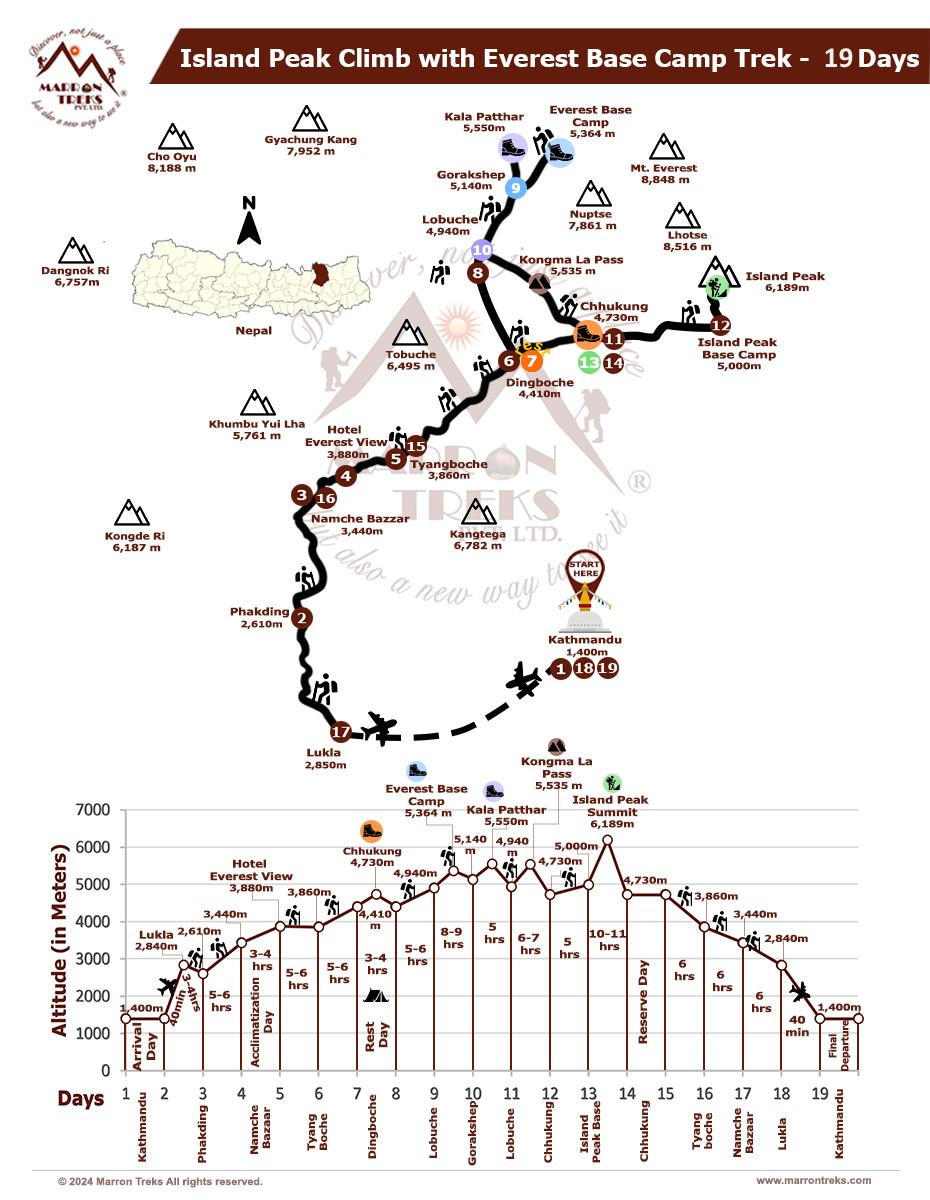
Trip Info
Accommodation
While you are in Kathmandu, we opt to accommodate you in 4- or 5-star hotels like Hotel Royal Singhi (4-star), Hotel Manaslu (4-star), Radisson (5-star), Yak & Yeti (5-star), or similar. During the trek, you will be accommodated in a local mountain lodge, better known as Tea House. These lodges and teahouses provide good services and are equipped with basic amenities. We will endeavor to provide you with the best accommodation available along the route so that you get a good night’s rest in a hygienic milieu.
Meals
We never compromise the quality of food or the health of the trekkers as well as the crew members. Generally, we opt for the fresh and nutritional local community food available. You could make your delicious pick from an array of traditional foods like Sweet potatoes, buckwheat barley, etc. This way, you could not only get a real sense of the local culture and life patterns but also contribute to promoting the locally available resources of organic food and beverages. Besides, a wide range of Continental, Chinese, Italian and Indian cuisines like Pizza, Spaghetti, French Fries, Soups, Breads, Masala curry, etc. are also available in the restaurants for your retreat.
Acclimatization
Altitude sickness is a serious risk while trekking in the Himalayas. It's important to acclimatize properly by spending a few days at lower altitudes before heading higher. By spending time at lower altitudes before pushing higher, your body has time to adjust. Our trekking packages have enough acclimatization days planned where you'll be spending a day or two at lower altitudes, allowing your body to adjust to the increasing altitude.
Electricity & drinking water
For an additional cost, you can use the electricity in all tea houses and lodges to recharge your batteries. The lodges have packaged mineral water for sale, or you can fill your bottle with boiling water. To make water drinkable, you can use water purification tablets too. But, due to hygienic issues, you should avoid drinking water from taps, rivers, or wells in trekking areas.
Communication
At lodges, restaurants, and hotels, Wi-Fi is available for an additional fee in the most popular trek regions, like Everest, and Annapurna. However, at high elevations, phone calls are the only means of connection. Our office in Kathmandu is in constant communication with your trek guide. In Kathmandu, you can purchase a local sim card for communication purposes. At high elevations, the mobile signal might not be as strong, though.
Luggage
Our porters are paired with one trekker for every two hikers, and one porter can safely carry 30 kg maximum weight. Therefore, we advise you to fill your duffle bag not more than 15 kg with your belongings. You may carry a small backpack with your valuables and informational documents. The things you are not taking along on the trek can be stored in a hotel in Kathmandu free of cost.
Typical Trek Day
Mostly your trek day starts with breakfast at 7-8 am, followed by a 3-4 hour morning trek. Lunch break is around an hour, then you continue trekking to your destination for the day. After reaching the teahouse lodge, you can relax, explore nearby areas, and enjoy dinner at 6-7 pm. Evenings involve socializing, a trek briefing, and leisure activities before bed.
Travel Insurance
It is advised that you arrange your travel insurance before leaving your homeland. The main thing is to make sure that your insurance covers you for both- medical and evacuation costs. Having travel insurance with you makes your trip secure and hassle-free.
Our Guides
Guides play a significant role during the trek. They are the ones who literally decipher the trekking codes for you so that you can actually connect with nature, culture and people along the way. We have helpful and dedicated trekking guides who are very well-versed in the culture, life patterns and every single detail pertaining to the trek region you are traveling in. Thus, in the company of our professional Sherpa guides, your trek becomes not only entertaining but also equally informative.
Porter and Staff Care
When it comes to high-altitude trekking, porters and staff members make up a pivot. Marron Treks ensures that all the porters and staff members going to high altitudes are provided with adequate clothing and equipment. All our field staff are covered by insurance.

